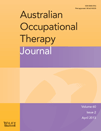Exploring the mobility preferences and perceived difficulties in using transport and driving with a sample of healthy and outpatient older adults in Singapore
Abstract
Background/aim
While activity engagement is important to older adults, limitations in ability can affect transport mode choice and subsequent activity participation. Therefore, this study aimed to explore the mobility preferences and difficulties in using public transport and driving with a sample of older adults in Singapore, with specific reference to accessing everyday activities.
Methods
One hundred and sixty-two persons aged 50 years and over were recruited through a community event, and an outpatient occupational therapy department. They self-completed structured questionnaire forms which were analysed using parametric and non-parametric statistics, including t-tests and ANOVAs.
Results
The majority of the participants were in the paid workforce and no significant differences were found between gender and the importance of transport for access to various activities, but a significant association was found for age and use of transport for going to work, F(5,101) = 3.07, P = 0.01. The majority of the drivers drove at least once a day, and 19% of them reported having noticed declines in their driving capabilities in the past four years, and indicated driving less often because of these concerns.
Conclusions
This study explored public transport and car use among a sample of older adults in Singapore to access desired activities. It identified difficulties with both public and private transportation use, such as difficulty maintaining balance/obtaining a seat, and concerns with decreased ability to respond quickly to traffic situations. This study has highlighted that transportation methods should be considered in occupational therapy practice with older adults.




